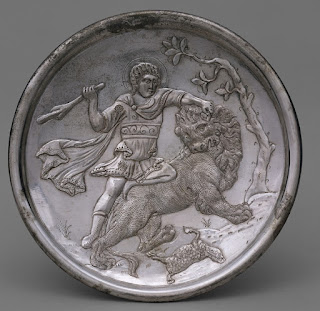Two silver plates from a set that seem to commemorate the great Byzantine victory over the Persians in 628-629. These both depict King David. Above he slays Goliath; below, the kills a lion.
This chalice emerged on the art market in the early 1900s. It was supposed to have been found at Antioch. People spun all sorts of stories about it:
The chalice's plain silver interior bowl was then ambitiously identified as the Holy Grail, the cup used by Christ at the Last Supper. The elaborate footed shell enclosing it was thought to have been made within a century after the death of Christ to encase and honor the Grail.So some rich New Yorker bought and gave it to the Met. These days it is dated to the 6th century and may actually be a lamp, not a drinking vessel. It isn't particular exciting as a work of art, but what a great story. Incidentally questions still hover around a lot of the stuff the Met's donors purchased in those decades, and several pieces they used to think were Byzantine are now dated to the 19th or early 20th century.
Panel from an ivory casket telling the story of Adam and Eve, c 1000. Eve is not enjoying the expulsion from paradise.
Mosaic depicting Ktisis, a figure personifying the act of generous donation or foundation, likely 6th century.
Two gold necklaces dated to the 6th century.Processional cross, c. 1100.Bronze vessel in the shape of a bear, 4th c.And a goblet from the Vrap Treasure, found in modern Albania in 1902. The best guess is that the hoard was assembled by the Avars. It includes both Byzantine pieces and pieces that seem to have been copies made by local smiths.Liturgical knife, 6th century.Niello ring depicting the Virgin and child, 10th century.This is just a small sample of the Met's vast holdings; I haven't included anything from the Asyut treasure, since I already blogged about that, and I recognized half a dozen other pieces as things I had probably posted before. How wonderful that so much survives from so long ago.
Mosaic depicting Ktisis, a figure personifying the act of generous donation or foundation, likely 6th century.
Two gold necklaces dated to the 6th century.Processional cross, c. 1100.Bronze vessel in the shape of a bear, 4th c.And a goblet from the Vrap Treasure, found in modern Albania in 1902. The best guess is that the hoard was assembled by the Avars. It includes both Byzantine pieces and pieces that seem to have been copies made by local smiths.Liturgical knife, 6th century.Niello ring depicting the Virgin and child, 10th century.This is just a small sample of the Met's vast holdings; I haven't included anything from the Asyut treasure, since I already blogged about that, and I recognized half a dozen other pieces as things I had probably posted before. How wonderful that so much survives from so long ago.





















No comments:
Post a Comment